I appear to be using glMultiDrawIndirect (MDI) and/or DrawElementsIndirectCommand (DEIC) incorrectly as I am not able to render all objects correctly. The method attempting to reuse draw commands for similar objects & textures ('instancing'...ish), draws all object in all locations. The 'debug' method simply uses 1 draw command per object (two triangles), but the output is always too few objects, with the first object's location never being used for any object.
This is what happens when using the failed attempt at instancing: 
This is what happens when using the 'debug' method of one object (two triangles) per DEIC: 
The goal would be to correctly use the instanceCount in DEIC to allow for something approaching instancing, while drawing the correct number of objects in the correct locations. My adventures in google-raiding has suggested that the baseInstance field of the DEIC could be used as the drawID if the DEICs are stored in a buffer. If this is impossible or if I am vastly misunderstanding the uses, please call me out and let me know! I have tried to include the smallest amount of applicable code to avoid a 10,000 word count post.
Below, I am creating "draw path" objects that are a collection of buffer IDs and vectors to be loaded into buffers (based on numerous variables unrelated to this question).
// VAO
glGenVertexArrays(1, &p->vertexArrayObject);
glBindVertexArray(p->vertexArrayObject);
// vertices
glCreateBuffers(1, &p->vertexBuffer);
glBindVertexBuffer(bindingIndex, p->vertexBuffer, 0, sizeof(Vertex));
glEnableVertexArrayAttrib(p->vertexArrayObject, 0);
glEnableVertexArrayAttrib(p->vertexArrayObject, 1);
glVertexAttribFormat(0, 3, GL_FLOAT, GL_FALSE, offsetof(Vertex, position));
glVertexAttribBinding(0, bindingIndex);
glVertexAttribFormat(1, 2, GL_FLOAT, GL_TRUE, offsetof(Vertex, uv));
glVertexAttribBinding(1, bindingIndex);
if(p->pathType == DrawPathType::FAST)
{
glNamedBufferStorage(p->vertexBuffer, p->rbVertices.bufferSize, nullptr, m_persistentCreateFlags);
p->rbVertices.ptr = (Vertex*)glMapNamedBufferRange(p->vertexBuffer, 0, p->rbVertices.bufferSize, m_persistentMapFlags);
p->rbVertices.bufferFragment = p->rbVertices.bufferSize / 3;
}
// indices
glCreateBuffers(1, &p->indexBuffer);
glVertexArrayElementBuffer(p->vertexArrayObject, p->indexBuffer);
// draw commands
// glCreateBuffers(1, &p->drawCmdBuffer);
// glBindBuffer(GL_DRAW_INDIRECT_BUFFER, p->drawCmdBuffer);
// glNamedBufferStorage(p->drawCmdBuffer, p->rbCommands.bufferSize, nullptr, m_persistentCreateFlags);
// p->rbCommands.ptr = (DEIC*)glMapNamedBufferRange(p->drawCmdBuffer, 0, p->rbCommands.bufferSize, m_persistentMapFlags);
// p->rbCommands.bufferFragment = p->rbCommands.bufferSize / 3;
// unsure how this works
// glEnableVertexArrayAttrib(p->vertexArrayObject, 2);
// glVertexAttribIFormat(2, 1, GL_UNSIGNED_INT, offsetof(DrawElementsIndirectCommand, baseInstance));
// glVertexAttribBinding(2, bindingIndex);
// glVertexBindingDivisor(bindingIndex, 1);
// draw IDs
glCreateBuffers(1, &p->drawIDBuffer);
glBindBuffer(GL_ARRAY_BUFFER, p->drawIDBuffer);
glEnableVertexAttribArray(2);
glVertexAttribIPointer(2, 1, GL_UNSIGNED_INT, sizeof(GLuint), 0);
glVertexAttribDivisor(2, 1);
// transforms
glCreateBuffers(1, &p->transformBuffer);
if(p->pathType == DrawPathType::LONG || p->pathType == DrawPathType::FAST)
{
glNamedBufferStorage(p->transformBuffer, p->rbTransforms.bufferSize, nullptr, m_persistentCreateFlags);
p->rbTransforms.ptr = (glm::mat4*)glMapNamedBufferRange(p->transformBuffer, 0, p->rbTransforms.bufferSize, m_persistentMapFlags);
p->rbTransforms.bufferFragment = p->rbTransforms.bufferSize / 3;
glBindBufferBase(GL_SHADER_STORAGE_BUFFER, 0, p->transformBuffer);
}
// texture addresses
glCreateBuffers(1, &p->textureAddressBuffer);
glBindBufferBase(GL_SHADER_STORAGE_BUFFER, 1, p->textureAddressBuffer);
This is the useful part of the 'renderPrep' function.
for(size_t i = 0; i < glyphs->size(); i++)
{
auto it = glyphs->at(i);
// ensure we have a valid texture address
if(!it->textureAddress.defined())
{
Logger::getInstance().Log(Logs::CRIT, Logs::Drawing, "Renderer2D::drawPrep()", "Iteration [{}] of [{}] has a null texture address (0,0)!", i, glyphs->size());
failed++;
}
else
{
offset = verts->size();
for(int in = 0; in < QUAD_VERTS; in++) { indices->push_back(baseQuadIndices[in] + offset); }
// creating our model space to world space matrix ('model' in "projection * view * model")
glm::mat4 transRotate = glm::rotate(identMat, glm::radians(it->angle), glm::vec3(0.0f, 0.0f, 1.0f));
transforms->push_back(transRotate);
transforms->back() = glm::translate(transforms->back(), it->position);
// push back modelspace vertices
for(auto& v : it->vertices) { verts->push_back(v); }
// update previous draw command or create a new one
if(currentTex.exists() && currentTex == it->textureAddress)
{
// append previous draw command
DEICs->back().vertexCount += QUAD_VERTS;
DEICs->back().instanceCount += 1; // two triangles, thus two instances
}
else
{
// different texture, new draw command
DEIC tmp = { QUAD_VERTS, 1, (inc * QUAD_VERTS), (inc * BASE_VERTS), inc };
DEICs->push_back(tmp);
currentTex = it->textureAddress;
}
/// \NOTE: Current issue is that the draw command is only drawing one object, in two iterations.
/// This is responsible for the blank second box
/* DEIC tmp = { QUAD_VERTS, 1, (inc * QUAD_VERTS), (inc * BASE_VERTS), 0 };
DEICs->push_back(tmp);
texAddrs->push_back(it->textureAddress); */
Logger::getInstance().Log(Logs::DEBUG, Logs::Drawing, "Renderer2D::drawPrep()",
"\n\033[93mDEIC #{}\033[0m:\n\tvertCount\t\t{}\n\tinstCount\t\t{}\n\tfirstInd\t\t{}\n\tbaseVert\t\t{}\n\tbaseInst\t\t{}\n",
DEICs->size(), DEICs->back().vertexCount, DEICs->back().instanceCount, DEICs->back().firstIndex, DEICs->back().baseVertex, DEICs->back().baseInstance);
texAddrs->push_back(currentTex);
p->drawIDs.push_back(inc);
inc++;
}
}
This is the snippet actually responsible for rendering.
int activeProgramID = 0; // currently used glsl program
glGetIntegerv(GL_CURRENT_PROGRAM, &activeProgramID);
// active passed glsl program id, or enable existing if not already enabled
if(glProgID > 0) { glUseProgram(glProgID); }
else if(activeProgramID == 0) { glUseProgram(m_prog->getProgramID()); }
// all clear, do it!
glBindVertexArray(p->vertexArrayObject);
// bind SSBOs, if applicable
if(p->transformBuffer) { glBindBufferBase(GL_SHADER_STORAGE_BUFFER, 0, p->transformBuffer); }
if(p->textureAddressBuffer) { glBindBufferBase(GL_SHADER_STORAGE_BUFFER, 1, p->textureAddressBuffer); }
// finally render
//if(p->drawCmdBuffer) { glBindBuffer(GL_DRAW_INDIRECT_BUFFER, p->drawCmdBuffer); glMultiDrawElementsIndirect(GL_TRIANGLES, GL_UNSIGNED_INT, 0, p->drawCommands.size(), 0); }
//else { glMultiDrawElementsIndirect(GL_TRIANGLES, GL_UNSIGNED_INT, p->drawCommands.data(), p->drawCommands.size(), 0); }
glMultiDrawElementsIndirect(GL_TRIANGLES, GL_UNSIGNED_INT, p->drawCommands.data(), p->drawCommands.size(), 0);
// update ring buffer(s), if applicable
if(p->rbCommands.ptr != nullptr) { m_bufferLockManager->lockRange(p->rbCommands.oldHead, p->rbCommands.bufferFragment); }
if(p->rbTransforms.ptr != nullptr) { m_bufferLockManager->lockRange(p->rbTransforms.oldHead, p->rbTransforms.bufferFragment); }
if(p->rbVertices.ptr != nullptr) { m_bufferLockManager->lockRange(p->rbVertices.oldHead, p->rbVertices.bufferFragment); }
// options specific to a "fast" draw path (if a fast draw path, glyphs are single use)
if(p->pathType == DrawPathType::FAST) { p->clear(true); }
// clean up
glBindVertexArray(0);
// change to previous glProgram
if(activeProgramID) { glUseProgram(activeProgramID); }
else { glUseProgram(0); }
EDIT #1, 2019-04-05 11:53a EST:
First, I forgot shaders! Apologies for missing this.
// --------- Vertex shader ------------
// uniforms / shader_storage_buffer object
layout(std140, binding = 0) buffer CB0 { mat4 Transforms[]; };
// view & projection in one
uniform mat4 ViewProjection;
// input
layout(location = 0) in vec3 In_v3Pos;
layout(location = 1) in vec2 In_v2TexCoord;
layout(location = 2) in uint In_uiDrawID;
// output
out DrawBlock
{
vec2 v2TexCoord;
flat uint iDrawID;
} Out;
void main()
{
mat4 World = Transforms[In_uiDrawID + gl_InstanceID];
vec4 worldPos = World * vec4(In_v3Pos, 1.0);
gl_Position = ViewProjection * worldPos;
Out.v2TexCoord = In_v2TexCoord;
Out.iDrawID = In_uiDrawID;
}
// --------- Fragment shader ------------
struct TexAddress
{
sampler2DArray arr;
float slice;
};
layout (std430, binding = 1) buffer CB1 { TexAddress texAddress[]; };
// input
in DrawBlock
{
vec2 v2TexCoord;
flat uint iDrawID;
} In;
// output
layout(location = 0) out vec4 Out_v4Color;
vec4 Texture(TexAddress addr, vec2 uv) { return texture(addr.arr, vec3(uv, addr.slice)); }
void main()
{
int DrawID = int(In.iDrawID);
Out_v4Color = vec4(Texture(texAddress[DrawID], In.v2TexCoord).xyz, 1.0f);
}
If I removed the drawIDs block using non-DSA and replace with the snippet below, it draws white triangles focusing on the center of the screen.
glCreateBuffers(1, &p->drawCmdBuffer);
glBindBuffer(GL_DRAW_INDIRECT_BUFFER, p->drawCmdBuffer);
glNamedBufferStorage(p->drawCmdBuffer, p->rbCommands.bufferSize, nullptr, m_persistentCreateFlags);
p->rbCommands.ptr = (DEIC*)glMapNamedBufferRange(p->drawCmdBuffer, 0, p->rbCommands.bufferSize, m_persistentMapFlags);
p->rbCommands.bufferFragment = p->rbCommands.bufferSize / 3;
glEnableVertexArrayAttrib(p->vertexArrayObject, 2);
glVertexAttribIFormat(2, 1, GL_UNSIGNED_INT, offsetof(DrawElementsIndirectCommand, baseInstance));
glVertexAttribBinding(2, bindingIndex);
glVertexBindingDivisor(2, 1);
EDIT #2 @ 2019-04-06 12:09p EST: Created a gist on github with the full header/source for the renderer. Link : https://gist.github.com/bbilyeu/bbf74ef4eaf979b5d2b4f2c2a9dcce48

